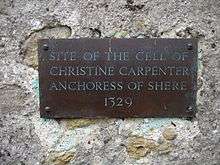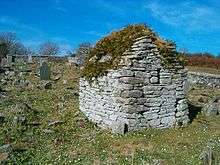Monastic cell
A cell is a small room used by a hermit, monk, anchorite or nun to live and as a devotional space. They are often part of larger communities such as Catholic and Orthodox monasteries and Buddhist vihara,[1] but may also form stand-alone structures in remote locations.
Etymology
The word cell comes from the Old French celle meaning a monastic cell, itself from the Latin meaning room,[2] store room or chamber.[3]
In Christianity
A cell in the Christian context is a name for the living quarters of monastics, either male or female. Usually, a monk's cell is small and contains a minimum of furnishings.
A cell may be an individual living space (room) in a building, usually within a cenobitic monastery, for a monk or nun, or it may refer to hermit's primitive solitary living space (possibly a cave or hut in the desert or forest) isolated from monasteries and other inhabited places. In a cenobitic setting the building of "cells” also contains communal rooms for eating. A small dependent or daughter house of a major monastery, sometimes housing just one or two monks or nuns, may also be termed a cell.
The first cells were in the Nitrian Desert in Egypt following the ministry of Paul of Thebes[4] Serapion and Anthony the Great.[5] in the mid 3rd century.
Buddhism
See Monastery#Buddhism
In Buddhism vihara is often restricted to the rainy season and the vihara retreat.
See also

- Hermitage (religious retreat)
- Ashram in Hinduism
- Poustinia in Orthodox Christianity
- Nazirite in Judaism
- Therapeutae in Judaism
- Prison cell
- Pachomius founder of cenobitic monasteries
- Kathisma
References
- ↑ Cell at Merriam Websters Dictionary.com.
- ↑ Cell at dictionary.reference.com.
- ↑ cell at Oxford Dictionary.
- ↑ St Pauls Monastery Egypt.
- ↑ Chryssavgis, John; Ware, Kallistos; Ward, Benedicta, In the Heart of the Desert: Revised Edition The Spirituality of the Desert Fathers and Mothers (World Wisdom Bloomington, Ind., 2008) p15.
- ↑ Wyndham Thomas (2012). Robert Saxton: Caritas. Ashgate Publishing, Ltd. pp. 16–20. ISBN 978-0-7546-6601-1.
